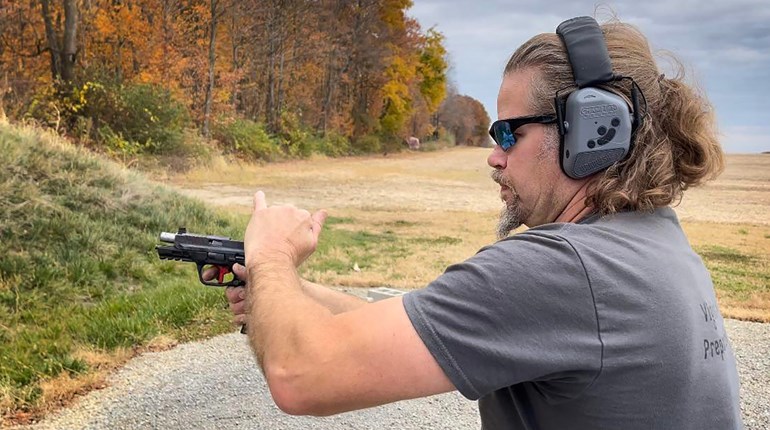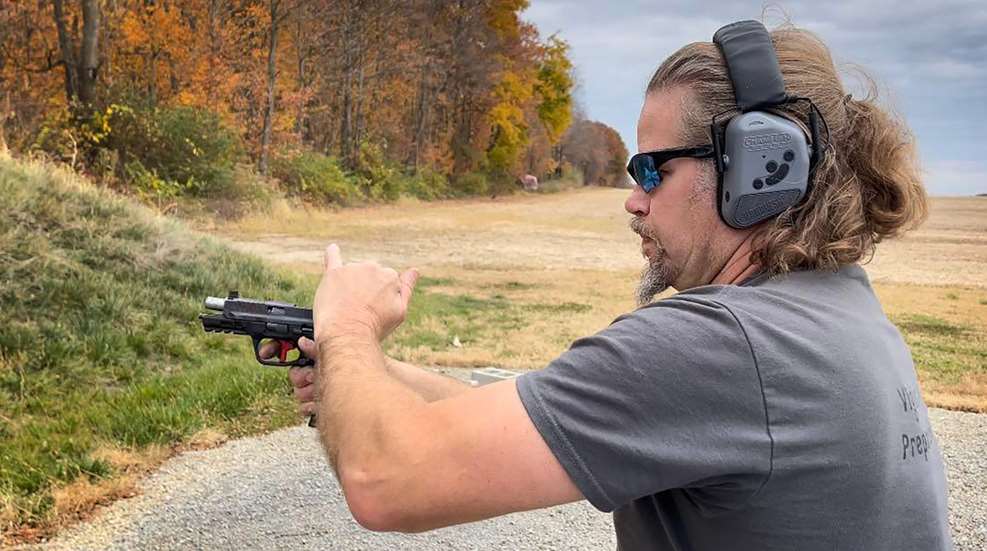
The self-defense community entertains considerable debate regarding the use of additional time for techniques that may provide beneficial to the defensive shooter. This article demonstrates comparison of the time it takes to perform the fastest technique foiled against the time it takes to perform additional measures which may offer benefit.
Experiment 1: "Get Off The X"
The first technique in question is movement during the draw stroke. With advice from my colleagues, I determined that there are four basic types of movement associated with shooting.
- Type 1: No movement except for the draw. This technique is sometimes referred to as “stand and deliver.”
- Type 2: The defender takes 1-2 steps simultaneously with the draw stroke. This technique is sometimes called “getting off the X.”
- Type 3: Shooting on the move. This technique is widely regarded by accomplished shooters as the least accurate method.
- Type 4: Moving to cover/concealment before engaging the Violent Criminal Attacker (VCA). This technique takes longer to engage the violent criminal actor with gunfire than the other three options.
The question at hand is whether Type 2 takes too long to perform compared to Type 1 in a defensive setting. Could that extra time cause you to lose the fight? For the purposes of this article, movement types 3 and 4 will not be discussed since it is not our goal to teach tactics. As retired Navy Seal Jeff Gonzales commented to me when I reached out to colleagues for assistance in defining the different types of movement: When you need to move, move. When you need to shoot, shoot. (paraphrased).
Before performing the experiment, my best educated guess was that Type 2 movement would not add significantly to the trained defensive shooter’s overall time, nor would it diminish the accuracy standard of hitting an 8” circle in common self-defense distances between 3-10 yards.
To test the times required for Type 1 vs Type 2 movement the following experiment was devised:
Each shooter in the experiment would be timed drawing their firearm from concealment and then firing two shots at the target. The first string of fire would be performed directly in front of the target with no lateral movement. The second string would require the shooter to move left until they had a good sight picture, and then firing two shots from a stationary position. The third string would be the same as the second except the shooter would move right instead of left.
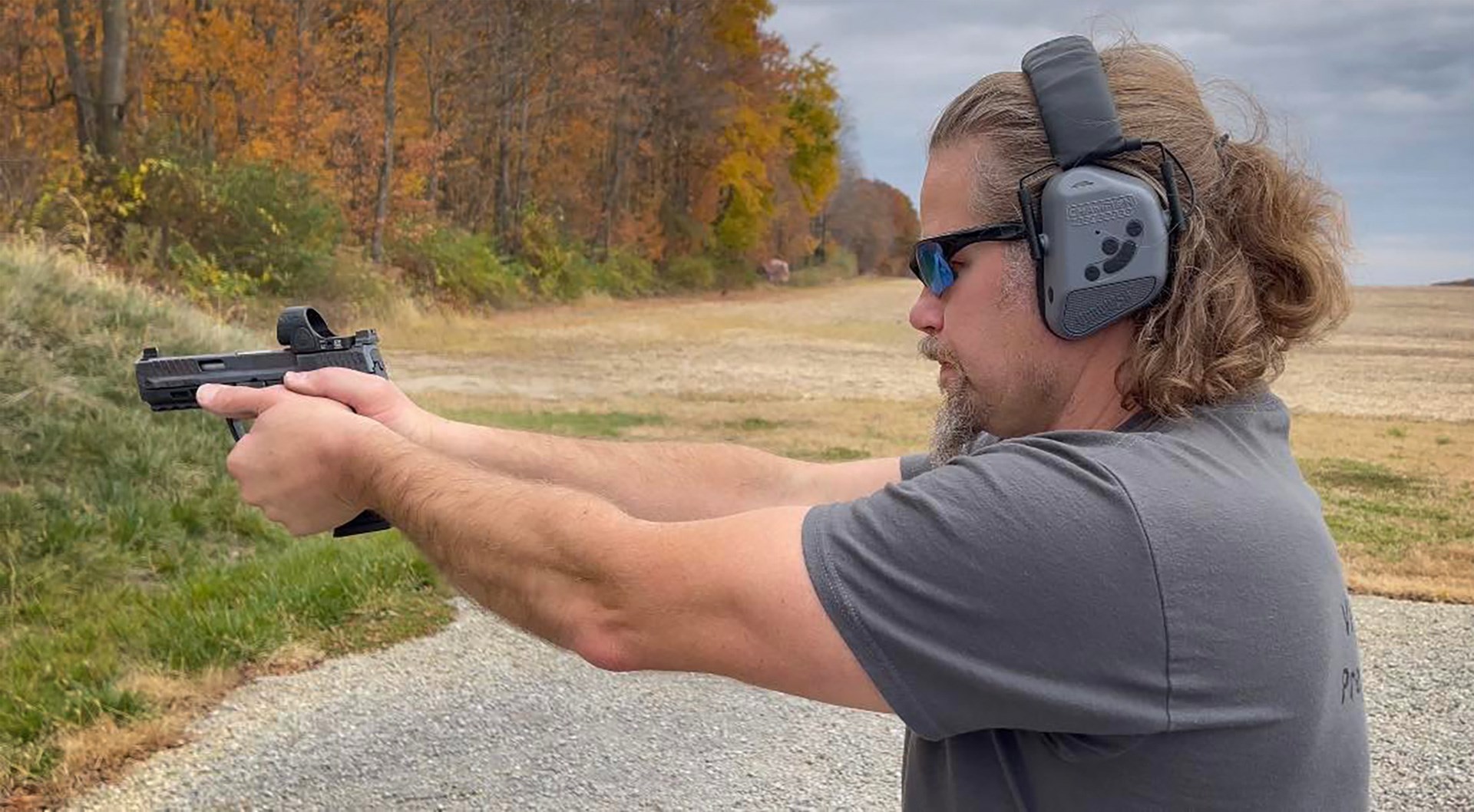
I selected myself and two other shooters to perform the experiment. In order to get the best idea of whether or not our results could be considered universal, I chose shooters who had all been trained but with different degrees of skill. I am a Rangemaster Master Instructor with hundreds of hours of training from schools all across the country. As such, I consider myself to be an advanced shooter, and I used a Smith & Wesson M&P with a Trijicon SRO Red Dot Sight (RDS). Our second shooter is a Safety Officer with who also used an M&P with a red dot and is of above average skill. Lastly, we brought in my teenage son who has had proper training but almost never practices. He was included as the least skilled shooter for the experiment. My son used a Walther PPQ with iron sights. All three of our firearms are chambered in 9mm.
The drill was simple, fire both shots into the 5-inch circle in the center of a Shoot Steel cardboard torso target. In order to decrease “recency artifact” or the variability in results due to warming up, we practiced the experiment at 3,5,7, & 10 yards for a total of 24 rounds. While not all rounds in practice were in the 5-inch circle, most were, and all of our impacts fell into the larger “combat effective” upper chest octagon measuring 9x 11.25 inches on the target.
Once warm up was complete, each shooter performed the drill at 3 yards on a timer. I selected the 3-yard mark as the distance because the goal was to compare movement against standing still when faces with an attacker, and I determined that the longer distance would give more potential for variability due to imperfect presentation and other variables. At three yards, I could mitigate uncontrolled variables to improve our confidence that the only variable making significant change in the score was movement, or the lack thereof.
Experiment 2: Skipping the “Tap” in “Tap, Rack and Roll”:
The second question I had revolves around the “tap” portion of malfunction resolution technique: “Tap, Rack, & Roll.” “Tap, Rack, & Roll” is what we call the procedure used to remedy certain malfunctions including misfires and failure of the shooter to chamber a round from a loaded magazine. The “tap” portion of the technique was created to solve the problem of a loose magazine by thumping the bottom of the magazine baseplate to ensure proper feeding. While many instructors and shooters have experienced malfunctions requiring a “tap” in training and competition environments, noted video researcher John P. Correia from Active Self Protection has stated that in the tens of thousands of analyzed gunfights he has only seen a “tap” once, and that one occurred after the fight was over. Other noted instructors have also suggested that the “tap” is unnecessary since the vast majority of malfunctions can be cleared by a simple “rack and roll.” Thus, the issue of whether instructors should teach the “tap” or whether it would be a good idea for students to learn it.
Will a “tap” cost me valuable time in a gunfight? Could it cost me my life? Is it worth learning since it seems to occur extremely rarely “in the streets?” Or would I be better off playing the odds, saving time, and getting back in the fight?
My best pre-experiment guess was the “tap” would add time, but it would be relatively insignificant. I guessed it would probably add 0.2-0.3 seconds to the technique. Why not more? Because a “tap” can be performed nearly simultaneously with retraction of the firearm towards the shooter’s body and into their “workspace.” Since we are already bringing the gun into our workspace (defined as the area in front of the shooter between the upper chest and eyes with a 90-degree bend in the arm) to perform the “rack & roll” portion of the technique.
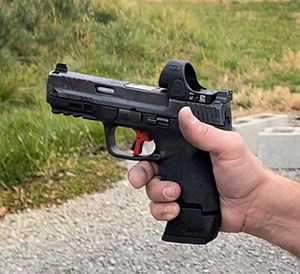 To test how much time a “tap” procedure would add to the overall malfunction clearance, I devised the following experiment:
To test how much time a “tap” procedure would add to the overall malfunction clearance, I devised the following experiment:
I would fire two shots into a USPSA target at 3 yards (again limiting distance to minimize undesired variables), but each shot would be aimed into the A-zone of the target to prevent recklessly fast gun handling. I used the same pistol for this experiment as the previous experiment, a Smith and Wesson M&P with a Trijicon SRO RDS chambered in 9mm.
The four strings of fire I designed to test my ideas were these:
- Control Group #1: This string represents the best-case scenario of a malfunction. One that would only require a “rack and roll” to resolve. The string would consist of the time it would take for me to shoot one shot, clear a dummy round by racking the slide, and shoot a second round. In the case of this type of malfunction, a “tap” would be completely unnecessary. This string was expected to the be the fastest since it involved the least amount of action.
- Experimental group #1: In this string I would shoot one round, perform an unnecessary “tap,” clear the dummy round with a “rack & roll,” then fire a second live round.
- Control group #2: In this string I will start with one loaded round, but leave the magazine slightly unseated which will result in an empty chamber after the first shot. I will then perform a necessary “tap,” rack the gun to load a round, and then fire the second round.
- Experimental group #2: This string represents the worst-case scenario in which a tap is required, but not performed immediately because the shooter has opted to skip the “tap” in their practice. In this string, the firearm will be set up as per Control group #2. I will fire one shot and then perform the “rack & roll” which will fail to resolve the malfunction due to the unseated magazine. Once the trigger has been pressed for the failed resolution, I will then perform the “tap, rack, and roll,” required to chamber a live round and then fire it.
In the experiment, I shot each string of fire until at least 5 times were acceptable close to each other representing my baseline capability. If my times improved after one or two runs or I experienced a much slower run in the middle of the string, I labelled those as practice/outliers and did not include them in the averages. At least one outlier was counted in each string of fire.
Experiment 1 ("Get Off The X") Results:
In the first experiment regarding movement the following times were recorded:
|
|
No movement |
Leftward movement |
Rightward movement |
|
Least skilled shooter |
1.93 seconds |
1.95 seconds |
1.98 seconds |
|
Moderately skilled |
1.57 seconds |
1.60 seconds |
1.57 seconds |
|
Most skilled |
1.41 seconds |
1.49 seconds |
1.38 seconds |
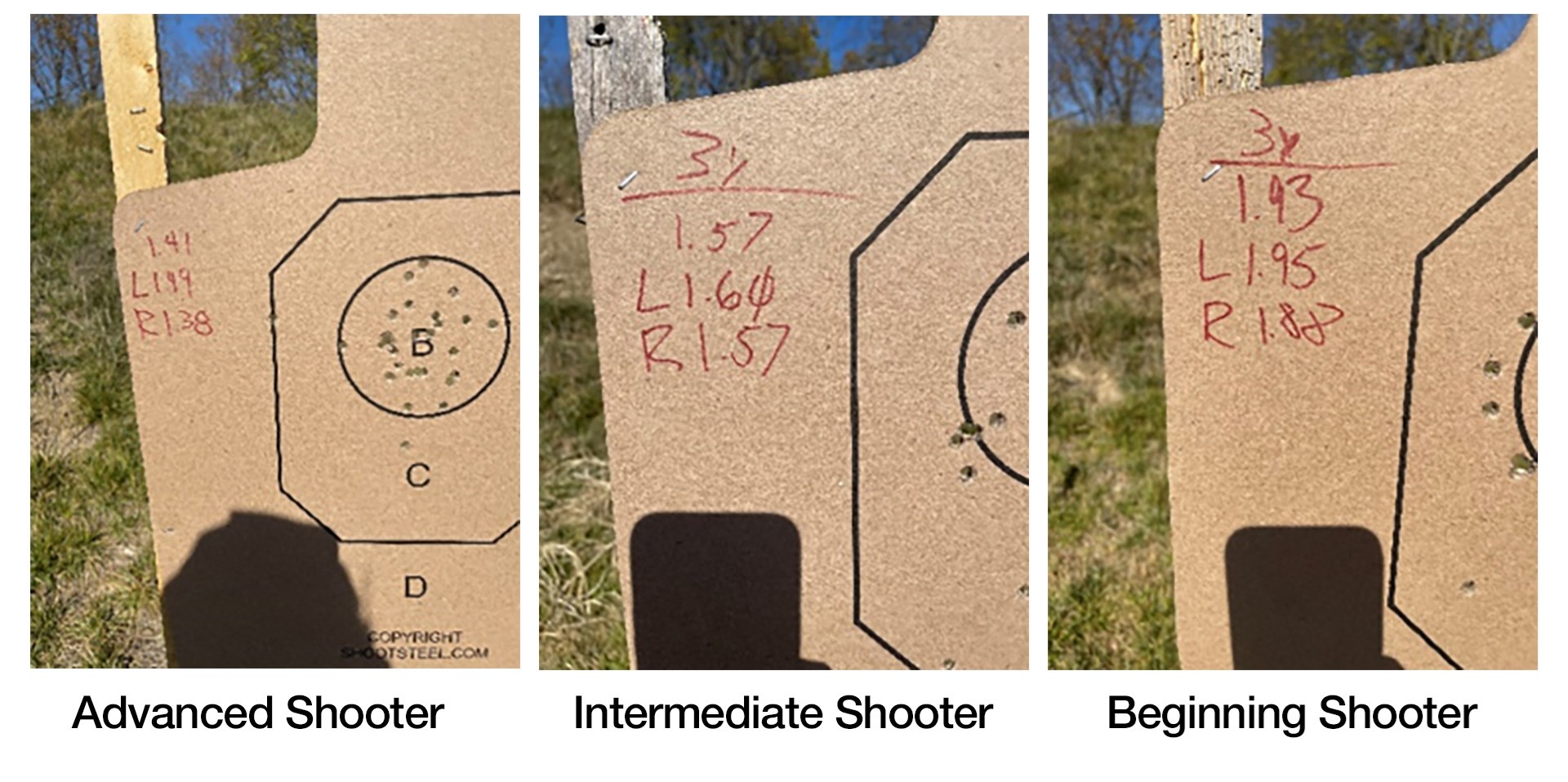
All shots were within the “combat effective zone” and most were inside the 5” circle, as per the photo. Noted shortcoming: I took photos only of the times, realizing later that full target photos might have improved the strength of my hypothesis. As such, the reader will have to take my word for the adequate accuracy. From left to right: My target, the RSO’s target, my son’s target.
Experiment 2 ("Tap, Rack, Roll") Results
In the second experiment regarding tap, rack and roll, the following times were collected:
|
Shot number |
1 |
2 |
3 |
4 |
5 |
6 |
7 |
8 |
|
Control 1 |
1.40 secs |
1.52 secs |
1.31 secs |
1.23 secs |
1.22 secs |
1.16 secs |
1.21 secs |
1.26 secs |
|
Experiment 1 |
1.42 secs |
1.32 secs |
1.28 secs |
1.18 secs |
1.19 secs |
1.24 secs |
1.19 secs |
Null |
|
Control 2 |
1.33 secs |
1.21 secs |
1.38 secs |
1.28 secs |
1.30 secs |
1.20 secs |
Null |
Null |
|
Experiment 2 |
2.68 secs |
2.84 secs |
2.39 secs |
2.55 secs |
2.52 secs |
2.34 secs |
2.34 secs |
2.47 secs |
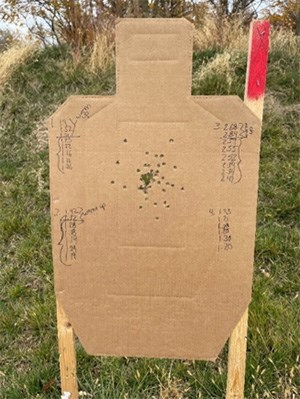 In the photo the reader can see that all shots were held to the A zone except for 1, which is just outside the line. This suggests that the tested times have defensive legitimacy. Also note that the Control #2 and Experimental #2 groups were shot out of order at the range. The Control #2 group was fired after the Experimental Group #2. This was not planned but coincided with a video that was taken at that time. I do not think that reversing the order changed the results in any significant way, though admittedly I had the most practice before performing Control #2/String 4 at the range, so any added benefit I had in terms of time could be attributed to additional practice.
In the photo the reader can see that all shots were held to the A zone except for 1, which is just outside the line. This suggests that the tested times have defensive legitimacy. Also note that the Control #2 and Experimental #2 groups were shot out of order at the range. The Control #2 group was fired after the Experimental Group #2. This was not planned but coincided with a video that was taken at that time. I do not think that reversing the order changed the results in any significant way, though admittedly I had the most practice before performing Control #2/String 4 at the range, so any added benefit I had in terms of time could be attributed to additional practice.
Averages in each string:
- Control 1: No tap required. Rack and roll only: 1.216 sec. (Times 1-3 were determined to be practice/outliers.)
- Experimental 1: No tap required. Tap, rack, and roll: 1.216 sec. (Times 1&2 were determined to be practice/outliers.)
- Control 2: Tap required. Tap, rack, and roll: 1.264 sec. (Time 3 was determined to be an outlier.)
- Experimental 2: Tap required. Fail to tap, rack and roll, then recognize the mistake, tap, rack, and roll: 2.435 sec. (Times 1&2 were determined to be practice/outliers.)
Discussion:
Experiment 1: “Get Off The X”
The result of these experiments indicates that there is little to no detriment to a shooter with good training, even if they do not practice regularly, in terms of accuracy or speed if they move “off the X.” While different shooters may have better or worse accuracy and time, it is likely that with proper training the defender would see little to no difference between standing still or moving one step to either direction during the draw. As such, I see no practical speed or accuracy detriment to “getting off the X” while drawing as long as context is permissive.
Experiment 2: “Tap, Rack, Roll”
With regard to whether or not a “tap” is detrimental, my results showed a surprising lack of time difference between the control and experimental strings when a tap was not required. I hypothesized that there would be up to a 0.3 second difference, but the average times were exactly the same. This being the case, I cannot see any reason to omit the “tap.”
In the case of a malfunction that requires a “tap” and a “tap” is not immediately performed, there is a clear and marked loss of time. There is no question that performing the “tap” immediately when such a procedure is necessary is nearly twice as fast as starting with the “rack and roll” only.
Overall, there seems to be no time detriment to performing a tap but there is a possible time detriment if a tap is needed and not performed. It is my estimation that if there is a large degree of variability in a shooter’s results, it is because there exists a lack of training and automaticity, rather than a problem with the principles we have discussed.
Shortcomings of the Study:
In retrospect, I regret not timing the movement study at all distances 3,5,7 and 10 yards. However, I believe that while the times might have gotten slower as the distance increased, each shooter would have retained relatively similar times as long as variables such as the presentation remained equal in each attempt. Therefore, the lack of recorded times is probably inconsequential, but it does leave open the possibility of more testing in the future.
Additional repetitions and subjects may increase variability in time scores, so adding more subjects and attempts within each string might have changed the results. However, with three shooters all shooting scores so similar in all three strings, I think it is unlikely that adding additional properly trained shooters would change the result.
Regarding the “tap” experiment, there exists an obvious bias. As the experiment continued, I had more practice and its reasonable to assume I was getting faster as the experiment progressed. This is a legitimate concern but unavoidable for any significant length of drilling. I think that the effect was minimally important though since after the first 1-3 iterations of each string my times were very similar. I suspect that returning to the range another day and performing the same experiment in reverse order would result in very little difference.
Along those lines, I would like to point out the difference between experimental group #1 and control group #2, which had almost the same procedures and times (1.216 seconds and 1.264 seconds, respectively). The only difference in procedure between these groups was that the magazine in control group 2 was slightly loose and a tap was needed to re-seat it. In the order these strings were performed on the range, experimental group 1 was 2nd and control group 2 was 4th. I think that the relative closeness of results in these two groups shows that the benefits of getting “warmed up” had already been maximized or close to it by the time I shot the last string.
Conclusions:
In my estimation, there is no reason why a defender should not move off the X if the context allows them to do so. In fact, there is a potential detriment to standing in place as the defender will be an easier target for the violent criminal actor. Nor is there any good reason to avoid tapping the magazine baseplate to ensure proper engagement when a malfunction occurs. There is, however, a much larger time cost for those who remove the “tap” from their procedure if the rare necessity of a “tap” is required.
Acknowledgements:
I would like to thank my colleagues John Correia, Karl Rehn, John Hearne, Riley Bowman, Phil Wong, and Mike Ox for they have done to make experiments like this possible and meaningful. It is their data and theory that allows use of terms such as automaticity, standards that give high positive predictive value to being a successful self-defender and analyzing data to determine real world solutions to violent criminal behavior.
Also, thanks to Susan Rosenberg who helped me with the study and to Greg Ellifritz who is a constant sounding board and inspiration for me. They both assisted with editing and peer review of this article.












